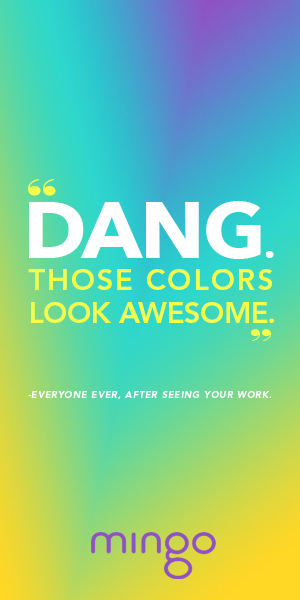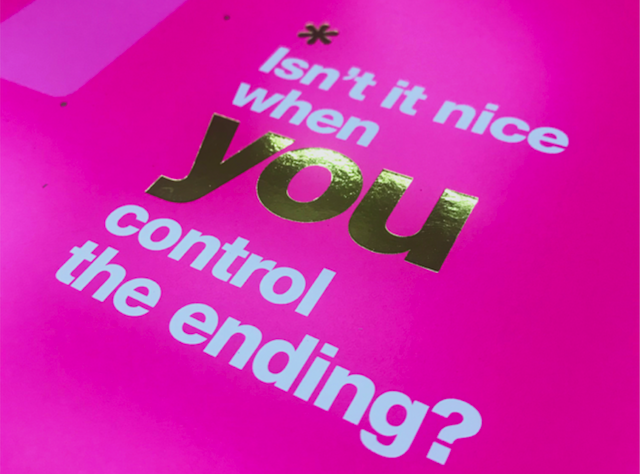Sam stared at her computer screen.
Something was off in the kerning. The g was just a tad too far away from the o. As she reached for her mouse, a bee urgently tapped her wrist.
Her watch said she had to go.
“Aaaaaiiiiiiigggghhhhhhh!!!!!!”
“Well, I’ll fix the kerning, then I’ll send the file to mingo. They’ll help make sure everything’s right before they print it.”
“People talk in stories, and so must we.”
This advice is from Luke Sullivan in his iconic book, “Hey Whipple, Squeeze This: The Classic Guide to Creating Great Ads.” Yes, he is a writer. Sometimes writers have good ideas, too.
Sullivan, of course, was talking directly to those who work in advertising, but the truth of that statement transcends industry. But if you take that statement, remove it from the context of advertising, and change “we” to “I,”—People talk in stories, and so must I—you have a fundamental truth about the nature of human connection.
Or, to quote Joan Didion, “We tell ourselves stories in order to live.”
Those stories give life a narrative.
Narrative is what gives human experience meaning. Narrative is what triggers emotion, and empathy. If you’re moved by a laughing child, it’s not so much because of the act itself, but the clues that accompany it: the child’s facial expressions, the tickle in her tone, the twinkle in her eye.
These “tells” tell a story.
“Researchers have found that the human brain has a natural affinity for narrative construction,” science journalist Benedict Carey wrote in New York Times Magazine. “People tend to remember facts more accurately if they encounter them in a story rather than in a list, studies find; and they rate legal arguments as more convincing when built into narrative tales rather than on legal precedent.”
We think in story.
Joseph Campbell touched on this in “The Hero with a Thousand Faces,” where he fleshed out the “Monomyth,” known more commonly as “The Hero’s Journey”—his idea that the same narrative has been told throughout the ages, from “The Odyssey” to “Star Wars.”
Why do we tell stories? To share information, to share inspiration, to share in the entire experience of being human. Stories connect us to each other in profound and moving ways.
Science is backing this up.
Jennifer Aaker, a marketing professor at Stanford’s Graduate School of Business, asked each of her students to give a 1-minute pitch. Just 1-in-10 of them told a story in their pitch while the rest used facts and figures. Afterwards, just 5% could recite a statistic while 63% remembered the story.
 “Research shows our brains are not hard-wired to understand logic or retain facts for very long. Our brains are wired to understand and retain stories,” Aaker says. “A story is a journey that moves the listener, and when the listener goes on that journey they feel different and the result is persuasion and sometimes action.”
“Research shows our brains are not hard-wired to understand logic or retain facts for very long. Our brains are wired to understand and retain stories,” Aaker says. “A story is a journey that moves the listener, and when the listener goes on that journey they feel different and the result is persuasion and sometimes action.”
As creative professionals, that is what we strive to do. Using words and images, our job is to inspire people to act – to click, to call, to buy, to give, to support. Storytelling is what we do: we build visual narratives, often to complement and expand written ones.
From the earliest cave drawings, artists have been telling stories through imagery for more than 40,000 years. Today, we have more mediums than ever but the importance of story is still the same. You know this. Font choices, color, imagery, style, placement, even the paper itself, all help shape the story you tell through design every day.
But the more you become aware of the structure of an actual storyline, the more powerful – and effective – your work will become. “Following similar steps to that of a traditional writer—nailing down your story, defining your visual grammar, developing a story arc, and finding threads to weave through the entire narrative—you’ll be able to design content that makes a lasting impact on your audience,” says Ashley Anderson in her Visual Storytelling post on the Ceros Blog.
Our job is to help you share those stories with the world.
Our 2017 marketing campaign is a tribute to all the creative storytellers like you:
The Story of Creative Thinkers
(And their cohorts who figure out how to get those creative ideas printed.)*
*We can help.
For all the professionals in the creative fields, yours is a story of imagination and achievement.
Here at Mingo, we take that very seriously.
That’s why we have designated teams to work with you and oversee your jobs.
That’s why we invest in printing technologies for color matching and rigorous quality controls.
That’s why we personally bust it every day to help you meet deadlines.
That’s why we’ve built a company specifically designed to make sure your story has a happy ending, every single time.
We’ve met many talented professionals over the years, and each one has a story worth sharing. We’d love to hear yours. To get you started, here are some of the characters we’ve come to know and love over the years.
 Which one are you?
Which one are you?
Are you the Designer? The Copywriter? The Marketer? The Printer? The Project Manager? Click one of these links to see all the characters and get your own free wallpaper to show off the “tells” of your story.
Here’s our story: Mingo is a small company run by a bunch of very passionate human beings with a dry sense of humor and a deep desire to serve the needs of our very creative customers. We’ve been doing that very thing for more than 40 years, and we’ve got the stories to prove it.
Let us help you tell all of yours.



